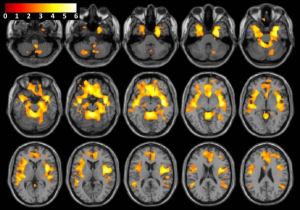
Ultrasound is widely used in medicine to reveal what’s happening inside the body, but scientists at Virginia Tech have found that ultrasound can also modulate brain activity to heighten sensory perception in humans. Researcher William Tyler (pictured) said his team’s work provides the first proof that low-intensity, transcranial-focused ultrasound can modulate human brain activity to enhance perception.
Reporting on the work in Nature Neuroscience, Tyler explained how he delivered focused ultrasound to an area of the cerebral cortex that processes sensory information received from the hand. He then stimulated the median nerve (a major nerve that runs down the arm) and recorded the subjects’ brain responses using electroencephalography (EEG). The team of researchers found that the use of ultrasound decreased the intensity of the brainwave signals recorded via EEG.
The scientists then administered two classic neurological tests: the two-point discrimination test, which measures a subject’s ability to distinguish whether two nearby objects touching the skin are truly two distinct points, rather than one; and the frequency discrimination task, a test that measures sensitivity to the frequency of a series of air puffs.
What Tyler found was unexpected. The subjects receiving ultrasound showed significantimprovements in their ability to distinguish pins at closer distances and to discriminate small frequency differences between successive air puffs.
“Our observations surprised us,” said Tyler. “Even though the brain waves associated with the tactile stimulation had weakened, people actually got better at detecting differences in sensations.”
To understand how well they could pinpoint the effect, the research team moved the ultrasound beam one centimeter in either direction of the original site of brain stimulation – and the effect disappeared.
“That means we can use ultrasound to target an area of the brain as small as the size of an M&M,” Tyler said. “This finding represents a new way of noninvasively modulating human brain activity with a better spatial resolution than anything currently available.”
Tyler speculates that the new work could open the door to safe and effective noninvasive ways to modulate the flow of information in cellular circuits within the living human brain. “In neuroscience, it’s easy to disrupt things,” he said. “We can distract you, make you feel numb, trick you with optical illusions. It’s easy to make things worse, but it’s hard to make them better. These findings make us believe we’re on the right path.”
Related:
Discuss this article in our forum
Gene expression altered with meditation
Brain mapping gets a reality check
Brain-training claims questioned
Sports brain injury may actually be an autoimmune phenomenon








Comments are closed.